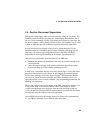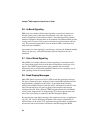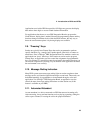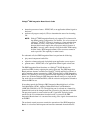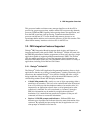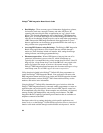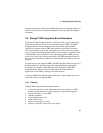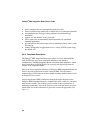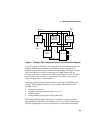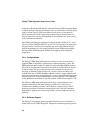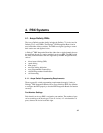Dialogic
®
PBX Integration Board User’s Guide
• Read displays - There are many types of information displayed on a phone;
for instance, hook state, messages, features, and other ASCII text. By
capturing and processing this data, an application can “see” what is on the
display. This can help determine the state of the Dialogic
®
PBX Integration
Board. Also, if ANI and DNIS digits are available through the PBX, the CO
caller ID can be obtained. Display data also can be useful when programming
a PBX. Because the PBX Integration Boards allow applications to “press”
buttons, applications can be written to program the PBX in the same way as
using a station set to program the PBX.
• Accessing PBX features using dial strings - The Dialogic
®
PBX Integration
Board allows applications to access features that are available through a
station set. These functions include call transfer, hold, setting the message
waiting indicator, and dialing programmable keys.
• Disconnect supervision - When a PBX detects a hang-up from one of its
extensions, information is passes to the CO, which in turn hangs up.
Typically this is accomplished using a loop current drop. However, if the CO
hangs up first, a loop current drop is sent to the PBX but is not passed to the
station set. Instead, the station set receives a disconnect message. The
Dialogic
®
PBX Integration Board interprets this disconnect message as a loop
current drop event. Not all PBXs support disconnect supervision.
Utility functions included in the Dialogic
®
Unified API allow programmers to
control the Dialogic
®
PBX Integration Board. Your application can retrieve the
PBX integration channel and board type, obtain and set PBX integration channel
and board parameters, retrieve Dialogic
®
D/42 firmware/driver/library version
numbers, and retrieve error information.
Using the Dialogic
®
Unified API to determine the type of switch to which the
Dialogic
®
PBX Integration Board is connected enables programmers to create an
application that can provide specific control for each PBX. Specific control can
be accomplished using dial strings. Some examples are call transfer, call forward,
message waiting light manipulation, and pressing console buttons. The PBX
Integration Board is capable of performing most functions that are available to a
telephone connected to the PBX.
Developers who wish to continue designing switch-specific applications can
choose to do so, as the Dialogic
®
Unified API also provides access to lower-level
function calls made available through each individual switch protocol. And for
30




